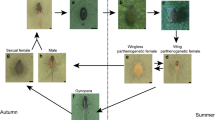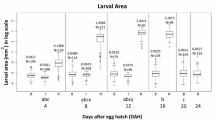Abstract
Changes in the physiological status of the host rice plant had a profound effect on wing morphism in the brown planthopper, Nilaparvata lugens (Stål). Significant increases in macroptery in the hopper progenies reared on senescent or hopperburned hosts occurred mainly because of a general decline in the host’s nutritional status and allelochemic factors. Starvation of young nymphs on nutritionally-depleted hosts probably inhibits the secretion of juvenile hormone by the corpus allatum, suppressing brachyptery and expressing macroptery. Also, any juvenilizing effect of the host’s allelochemics would tend to dissipate with the host’s senescence. Therefore, the proportion of macroptery in the hopper progeny developing on the rice host plant is determined by the extent of depletion of the host’s nutritional allelochemic factors. The observed significant increase in macroptery at a density of 50 or more hoppers per plant may have also been mediated through the host plant. Brown planthopper progenies of macropterous and brachypterous Biotypes 1, 2, 3 and the field population differed in their expression of macroptery probably because of their inherent differences in sensitivity to macropteryinducing stresses.
Similar content being viewed by others
References
Bonnemaison L. (1951) Contribution â l’etude des facteurs provoquant l’apparition des formes ailées et sexuées chez les Aphidinae. Annls. epiphyt. 2, 1–380.
Cagampang G. B., Pathak M. D. and Juliano B. O. (1974) Metabolic changes in the rice plant during infestation by the brown planthopper, Nilaparvata lugens Stål (Hemiptera:Delphacidae). Appl. Ent. Zool. 9, 174–184.
Dyck V. A., Misra B. C, Alam S., Chen C. N., Hsieh C. Y. and Rejesus R. S. (1979) Ecology of the brown planthopper in the tropics. In Brown Planthopper: Threat to Rice Production in Asia, pp. 61–98. Proceedings of the Symposium at the International Rice Research Institute, April 1977. Los Baños, Laguna, Philippines.
Harrewijn P. (1978) The role of plant substances in polymorphism of the aphid Myzus persicae. Ent. exp. appl. 24, 198–214.
Herout V. (1970) Some relations between plants, insects and their isoprenoids. In Progress in Phytochemistry (Ed. by Reinhold L. and Liwschitz Y.), Vol. 2, pp. 143–202. Interscience, New York.
Hinckley A. D. (1963) Ecology and control of rice plant-hoppers in Fiji. Bull. ent. Res. 54, 467–481.
International Rice Research Institute (1979) Research highlights for 1978. Los Baños, Laguna, Philippines. 118 pp.
Johansson A. S. (1958) Relation of nutrition to endocrine-reproductive functions in the milkweed bug, Oncopeltus fasciatus (Dallas). Nyt. Mag. Zool. 7, 1–132.
Johno S. (1963) Analysis of the density effects as a determining factor of the wing-form in the brown planthopper, Nilaparvata lugens. Jap. J. appl. Ent. Zool. 7. 45–48 (in Japanese, with English Summary).
Kisimoto R. (1956) Effect of crowding during the larval period on the determination of wing form of an adult planthopper. Nature 178, 641–642.
Kisimoto R. (1957) Studies on the polymorphism in the planthoppers (Homoptera, Araeopidae)—III. Differences in several morphological and physiological characters between two wing-forms of the planthoppers. Jap. J. appl. Ent. Zool. 1, 164–173.(in Japanese, with English Summary).
Kisimoto R. (1965) Studies on polymorphism and its role in the population growth of the brown planthopper, Nilaparvata lugens Stål. Bull. Shikoku agric. Exp. Stn. 13, 1–106.(in Japanese, with English Summary).
Kuno E. (1979) Ecology of the brown planthopper in temperate regions. In Brown Planthopper: Threat to Rice Production in Asia, pp. 45–60. Proceedings of the Symposium at the International Rice Research Institute, April 1977. Los Baños, Laguna, Philippines.
Kusakabe S. (1979) Dispersal of the Brown planthopper, Nilaparvata lugens Stål (Hemiptera:Delphacidae) in relation to its population growth. Appl. Ent. Zool. 14, 224–225.
Kusakabe S. and Hirao J. (1976) Tolerance for starvation in the brown planthopper, Nilaparvata lugens Stål (Hemiptera: Delphacidae). Appl. Ent. Zool. 11, 369–371.
Lees A. D. (1966) The control of polymorphism in aphids. Adv. Insect Physiol. 3, 207–277.
Mochida O. (1975) A strain producing abundant brachyp-terous adults in Nilaparvata lugens (Homoptera: Delphacidae). Ent. exp. appl. 18, 465–471.
Mori A. and Kiritani K. (1971) Accumulative effect of larval density on the determination of wing form in the brown planthopper (Nilaparvata lugens Stål). Jap. J. Ecol. 21, 146–152.
Nasu S. (1969) Vectors of rice viruses in Asia. In The Virus Diseases of the Rice Plant, pp. 93–109. Proceedings of the Symposium at the International Rice Research Institute, April 1967. John Hopkins Press, Baltimore, Maryland.
Rankin M. A. (1978) Hormonal control of insect migratory behavior. In Evolution of Insect Migration and Diapause (Ed. by Dingle H.), pp. 5–32. Springer, New York.
Sláma K. and Williams C. M. (1966) “Papaper factor” as an inhibitor of the embryonic development of the European bug, Pyrrhocoris apterus. Nature 210, 329–330.
Takeda M. (1974) Mating behavior of the brown planthopper, Nilaparvata lugens Stål. Jap. J. appl. Ent. Zool. 18, 43–51.
Vreeland N., Hurwitz G. B., Just P., Moeller P. W. and Shinn R. S. (1976) Area Handbook for the Philippines. American University, Washington, D.C., Foreign Area Studies.
Watanabe N. (1967) The density effect on the appearance of two wing-forms in the brown planthopper, Nilaparvata lugens and smaller brown planthopper, Laodelphax striatellus. Jap. J. appl. Ent. Zool. 11, 57–61.(in Japanese, with English Summary).
Whittaker R. H. (1970) The biochemical ecology of higher plants. In Chemical Ecology (Ed. by Sondheimer E. and Simeone J. B.), pp. 43–70. Academic Press, New York.
Wigglesworth V. B. (1954) The Physiology of Insect Metamorphosis, 152 pp. Cambridge University Press, London.
Wigglesworth V. B. (1970) Insect Hormones, 159 pp. W. H. Freeman, San Francisco.
Williams C. M. and Robbins W. E. (1968) Conference on insect-plant interactions. Biol. Sci. 18, 791–799.
Author information
Authors and Affiliations
Rights and permissions
About this article
Cite this article
Saxena, R.C., Okech, S.H. & Liquido, N.J. Wing Morphism in the Brown Planthopper, Nilaparvata Lugens. Int J Trop Insect Sci 1, 343–348 (1981). https://doi.org/10.1017/S1742758400000631
Received:
Published:
Issue Date:
DOI: https://doi.org/10.1017/S1742758400000631




